Tuning the Electronic and Optical Properties of the Novel Monolayer Noble-Transition-Metal Dichalcogenides Semiconductor β-AuSe via Strain: A Computational Investigation
Abstract
:1. Introduction
2. Materials and Methods
3. Results
3.1. Properties of Monolayer Strain-Free β-AuSe
3.1.1. Structural Properties
3.1.2. Electronic Properties
3.1.3. Optical Properties
3.2. Strain-Controllable Properties of Monolayer β-AuSe
3.2.1. Strain-Controllable Electronic Properties of Monolayer β-AuSe
3.2.2. Strain-Controllable Optical Properties of Monolayer β-AuSe
4. Conclusions
Supplementary Materials
Author Contributions
Funding
Acknowledgments
Conflicts of Interest
References
- Sun, Y.; Li, Y. Potential environmental applications of MXenes: A critical review. Chemosphere 2021, 271, 129578. [Google Scholar] [CrossRef] [PubMed]
- Penev, E.S.; Marzari, N.; Yakobson, B.I. Theoretical Prediction of Two-Dimensional Materials, Behavior, and Properties. ACS Nano 2021, 15, 5959–5976. [Google Scholar] [CrossRef] [PubMed]
- Tan, C.; Cao, X.; Wu, X.-J.; He, Q.; Yang, J.; Zhang, X.; Chen, J.; Zhao, W.; Han, S.; Nam, G.-H.; et al. Recent Advances in Ultrathin Two-Dimensional Nanomaterials. Chem. Rev. 2017, 117, 6225–6331. [Google Scholar] [CrossRef] [PubMed]
- Das, S.; Pandey, D.; Thomas, J.; Roy, T. The Role of Graphene and Other 2D Materials in Solar Photovoltaics. Adv. Mater. 2019, 31, e1802722. [Google Scholar] [CrossRef] [Green Version]
- Wang, Z.; Jingjing, Q.; Wang, X.; Zhang, Z.; Chen, Y.; Huang, X.; Huang, W. Two-dimensional light-emitting materials: Preparation, properties and applications. Chem. Soc. Rev. 2018, 47, 6128–6174. [Google Scholar] [CrossRef]
- Kundu, S.; Patra, A. Nanoscale Strategies for Light Harvesting. Chem. Rev. 2016, 117, 712–757. [Google Scholar] [CrossRef] [Green Version]
- Liu, W.; Liu, M.; Liu, X.; Wang, X.; Deng, H.X.; Lei, M.; Wei, Z.; Wei, Z. Recent Advances of 2D Materials in Nonlinear Photonics and Fiber Lasers. Adv. Opt. Mater. 2020, 8, 1901631. [Google Scholar] [CrossRef]
- Bhimanapati, G.R.; Lin, Z.; Meunier, V.; Jung, Y.; Cha, J.; Das, S.; Xiao, D.; Son, Y.; Strano, M.S.; Cooper, V.R.; et al. Recent Advances in Two-Dimensional Materials beyond Graphene. ACS Nano 2015, 9, 11509–11539. [Google Scholar] [CrossRef]
- Tan, C.; Zhang, H. Two-dimensional transition metal dichalcogenide nanosheet-based composites. Chem. Soc. Rev. 2015, 44, 2713–2731. [Google Scholar] [CrossRef]
- Chhowalla, M.; Shin, H.S.; Eda, G.; Li, L.-J.; Loh, K.P.; Zhang, H. The chemistry of two-dimensional layered transition metal dichalcogenide nanosheets. Nat. Chem. 2013, 5, 263–275. [Google Scholar] [CrossRef]
- Huang, X.; Zeng, Z.; Zhang, H. Metal dichalcogenide nanosheets: Preparation, properties and applications. Chem. Soc. Rev. 2013, 42, 1934–1946. [Google Scholar] [CrossRef] [PubMed]
- Lv, R.; Robinson, J.A.; Schaak, R.E.; Sun, D.; Sun, Y.; Mallouk, T.E.; Terrones, M. Transition Metal Dichalcogenides and Beyond: Synthesis, Properties, and Applications of Single- and Few-Layer Nanosheets. Acc. Chem. Res. 2014, 48, 56–64. [Google Scholar] [CrossRef] [PubMed]
- Chen, J.; Huang, Q.; Huang, H.; Mao, L.; Liu, M.; Zhang, X.; Wei, Y. Recent progress and advances in the environmental applications of MXene related materials. Nanoscale 2020, 12, 3574–3592. [Google Scholar] [CrossRef] [PubMed]
- Huang, H.H.; Fan, X.; Singh, D.J.; Zheng, W.T. Recent progress of TMD nanomaterials: Phase transitions and applications. Nanoscale 2020, 12, 1247–1268. [Google Scholar] [CrossRef]
- Jiang, T.; Yin, K.; Wang, C.; You, J.; Ouyang, H.; Miao, R.; Zhang, C.; Wei, K.; Li, H.; Chen, H.; et al. Ultrafast fiber lasers mode-locked by two-dimensional materials: Review and prospect. Photonics Res. 2019, 8, 78–90. [Google Scholar] [CrossRef]
- Kang, S.; Lee, D.; Kim, J.; Capasso, A.; Kang, H.S.; Park, J.-W.; Lee, C.-H.; Lee, G.-H. 2D semiconducting materials for electronic and optoelectronic applications: Potential and challenge. 2D Mater. 2020, 7, 022003. [Google Scholar] [CrossRef]
- Ke, J.; He, F.; Wu, H.; Lyu, S.; Liu, J.; Yang, B.; Li, Z.; Zhang, Q.; Chen, J.; Lei, L.; et al. Nanocarbon-Enhanced 2D Photoelectrodes: A New Paradigm in Photoelectrochemical Water Splitting. Nano-Micro Lett. 2020, 13, 24. [Google Scholar] [CrossRef]
- Qiu, Q.; Huang, Z. Photodetectors of 2D Materials from Ultraviolet to Terahertz Waves. Adv. Mater. 2021, 33, e2008126. [Google Scholar] [CrossRef]
- Tyagi, D.; Wang, H.; Huang, W.; Hu, L.; Tang, Y.; Guo, Z.; Ouyang, Z.; Zhang, H. Recent advances in two-dimensional-material-based sensing technology toward health and environmental monitoring applications. Nanoscale 2020, 12, 3535–3559. [Google Scholar] [CrossRef]
- Yao, J.; Yang, G. 2D material broadband photodetectors. Nanoscale 2020, 12, 454–476. [Google Scholar] [CrossRef]
- You, J.; Zhao, Y.; Wang, L.; Bao, W. Recent developments in the photocatalytic applications of covalent organic frameworks: A review. J. Clean. Prod. 2021, 291, 125822. [Google Scholar] [CrossRef]
- Rabenau, A.; Schulz, H. The crystal structures of α-AuSe and β-AuSe. J. Less Common Met. 1976, 48, 89–101. [Google Scholar] [CrossRef]
- Cranton, G.E.; Heyding, R.D. The gold/selenium system and some gold seleno-tellurides. Can. J. Chem. 1968, 46, 2637–2640. [Google Scholar] [CrossRef]
- Rabenau, A.; Rau, H.; Rosenstein, G. Phase relationships in the gold-selenium system. J. Less Common Met. 1971, 24, 291–299. [Google Scholar] [CrossRef]
- Machogo, L.F.; Tetyana, P.; Sithole, R.; Gqoba, S.S.; Phao, N.; Airo, M.; Shumbula, P.M.; Moloto, M.J.; Moloto, N. Unravelling the structural properties of mixed-valence α- and β-AuSe nanostructures using XRD, TEM and XPS. Appl. Surf. Sci. 2018, 456, 973–979. [Google Scholar] [CrossRef]
- Gong, P.-L.; Zhang, F.; Li, L.; Deng, B.; Pan, H.; Huang, L.-F.; Shi, X.-Q. Highly in-plane anisotropic 2D semiconductors β-AuSe with multiple superior properties: A first-principles investigation. J. Phys.: Condens. Matter 2019, 31, 395501. [Google Scholar] [CrossRef]
- Palyanova, G.A.; Seryotkin, Y.; Kokh, K.A.; Bakakin, V.V. Isomorphism and solid solutions among Ag- and Au-selenides. J. Solid State Chem. 2016, 241, 157–163. [Google Scholar] [CrossRef]
- Pi, L.; Li, L.; Liu, K.; Zhang, Q.; Li, H.; Zhai, T. Recent Progress on 2D Noble-Transition-Metal Dichalcogenides. Adv. Funct. Mater. 2019, 29, 1904932. [Google Scholar] [CrossRef]
- Lin, J.; Zuluaga, S.; Yu, P.; Liu, Z.; Pantelides, S.T.; Suenaga, K. Novel Pd2Se3 Two-Dimensional Phase Driven by Interlayer Fusion in Layered PdSe2. Phys. Rev. Lett. 2017, 119, 016101. [Google Scholar] [CrossRef] [Green Version]
- Machogo, L.F.E.; Mthimunye, M.; Sithole, R.; Tetyana, P.; Phao, N.; Ngubeni, G.N.; Mlambo, M.; Mduli, P.S.; Shumbula, P.M.; Moloto, N. Elucidating the structural properties of gold selenide nanostructures. New J. Chem. 2019, 43, 5773–5782. [Google Scholar] [CrossRef]
- Bai, P.; Guo, S.; Zhang, S.; Qu, H.; Zhou, W.; Zeng, H. Electronic band structures and optical properties of atomically thin AuSe: First-principle calculations. J. Semicond. 2019, 40, 062004. [Google Scholar] [CrossRef]
- Tang, C.; Zhang, L.; Zhang, C.; MacLeod, J.; Ostrikov, K.; Du, A. Highly stable two-dimensional gold selenide with large in-plane anisotropy and ultrahigh carrier mobility. Nanoscale Horiz. 2020, 5, 366–371. [Google Scholar] [CrossRef]
- Yin, Q.-K.; Yang, C.-L.; Wang, M.-S.; Ma, X.-G. Two-dimensional heterostructures of AuSe/SnS for the photocatalytic hydrogen evolution reaction with a Z-scheme. J. Mater. Chem. C 2021, 9, 12231–12238. [Google Scholar] [CrossRef]
- Kresse, G.; Furthmüller, J. Efficient iterative schemes forab initiototal-energy calculations using a plane-wave basis set. Phys. Rev. B 1996, 54, 11169–11186. [Google Scholar] [CrossRef]
- Kresse, G.; Joubert, D. From ultrasoft pseudopotentials to the projector augmented-wave method. Phys. Rev. B 1999, 59, 1758–1775. [Google Scholar] [CrossRef]
- Blöchl, P.E. Projector augmented-wave method. Phys. Rev. B Condens. Matter Mater. Phys. 1994, 50, 17953–17979. [Google Scholar] [CrossRef] [Green Version]
- Perdew, J.P.; Burke, K.; Ernzerhof, M. Generalized Gradient Approximation Made Simple. Phys. Rev. Lett. 1996, 77, 3865, Erratum: Phys. Rev. Lett. 1997, 78, 1396–1396. [Google Scholar] [CrossRef] [Green Version]
- Heyd, J.; Scuseria, G.E.; Ernzerhof, M. Hybrid functionals based on a screened Coulomb potential. J. Chem. Phys. 2003, 118, 8207–8215. [Google Scholar] [CrossRef] [Green Version]
- Heyd, J.; Scuseria, G.E. Efficient hybrid density functional calculations in solids: Assessment of the Heyd–Scuseria–Ernzerhof screened Coulomb hybrid functional. J. Chem. Phys. 2004, 121, 1187–1192. [Google Scholar] [CrossRef] [Green Version]
- Gajdoš, M.; Hummer, K.; Kresse, G.; Furthmüller, J.; Bechstedt, F. Linear optical properties in the projector-augmented wave methodology. Phys. Rev. B 2006, 73, 045112. [Google Scholar] [CrossRef] [Green Version]
- Patterson, J.; Bailey, B. Optical Properties of Solids. In Solid-State Physics: Introduction to the Theory, 2nd ed.; Springer: Berlin/Heidelberg, Germany, 2010; pp. 545–590. [Google Scholar]
- Tang, L.-P.; Tang, L.-M.; Geng, H.; Yi, Y.-P.; Wei, Z.; Chen, K.-Q.; Deng, H.-X. Tuning transport performance in two-dimensional metal-organic framework semiconductors: Role of the metal d band. Appl. Phys. Lett. 2018, 112, 012101. [Google Scholar] [CrossRef]
- Roldan, R.; Castellanos-Gomez, A.; Cappelluti, E.; Guinea, F. Strain engineering in semiconducting two-dimensional crystals. J. Phys. Condens. Matter 2015, 27, 313201. [Google Scholar] [CrossRef] [PubMed]

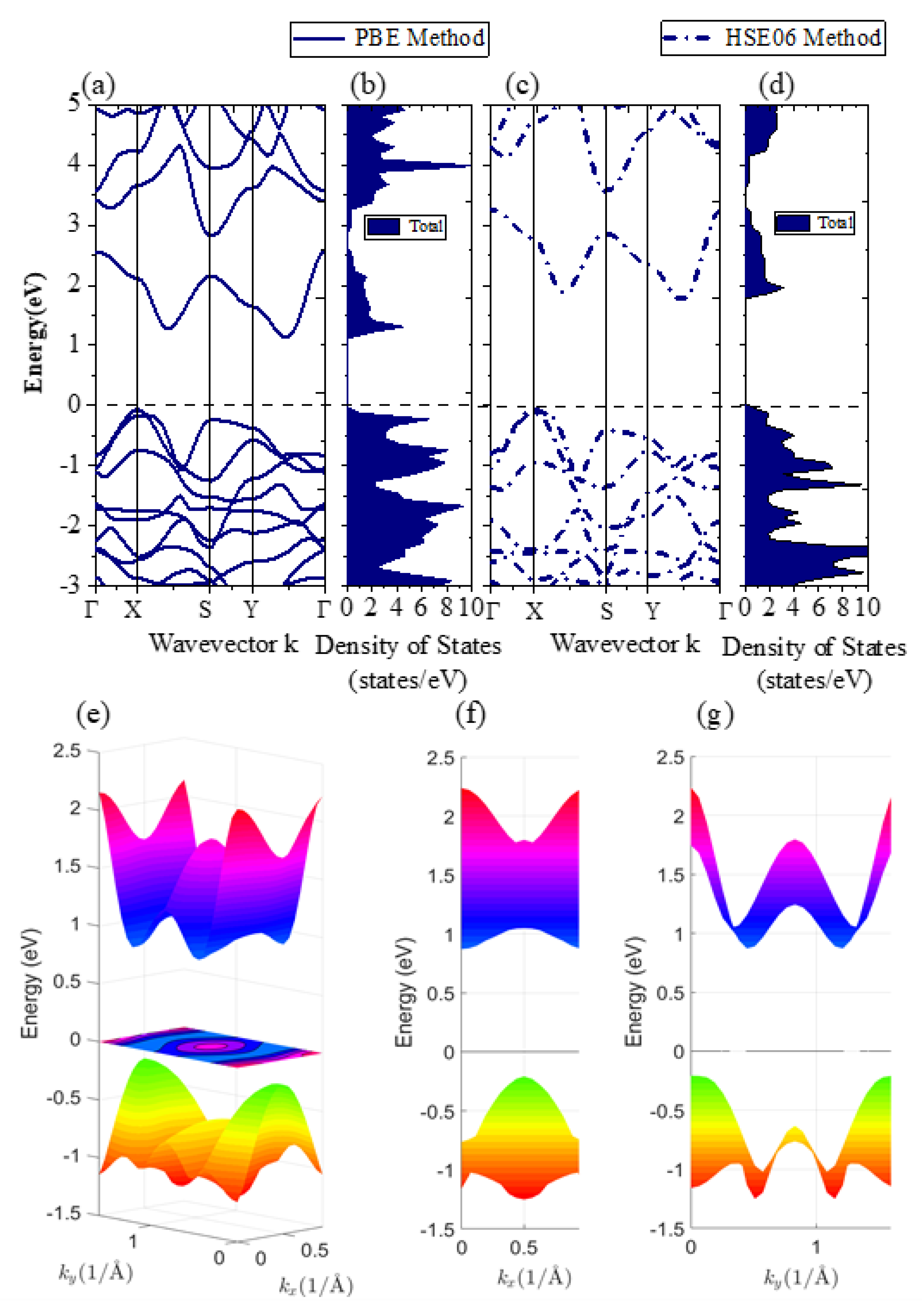


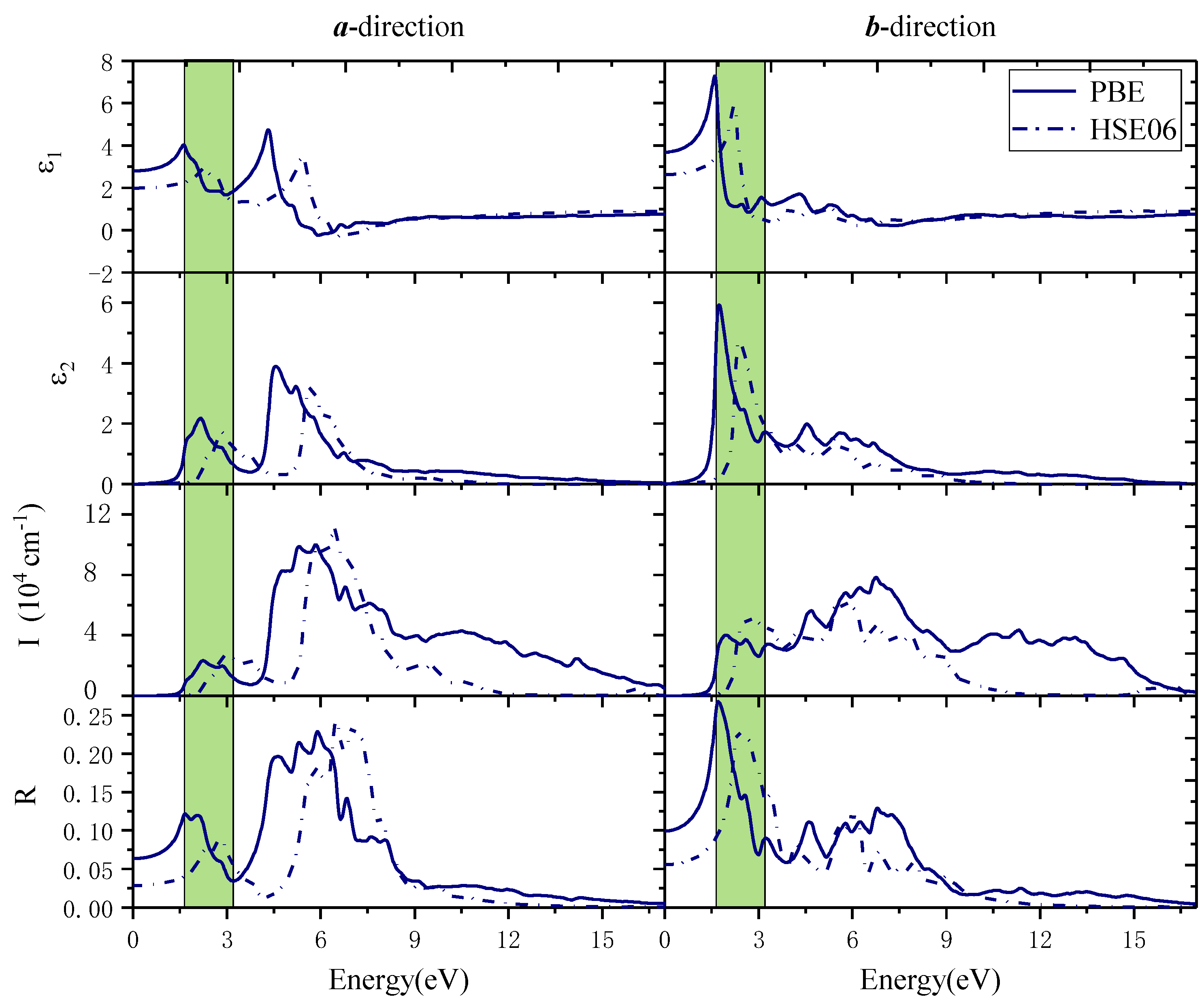
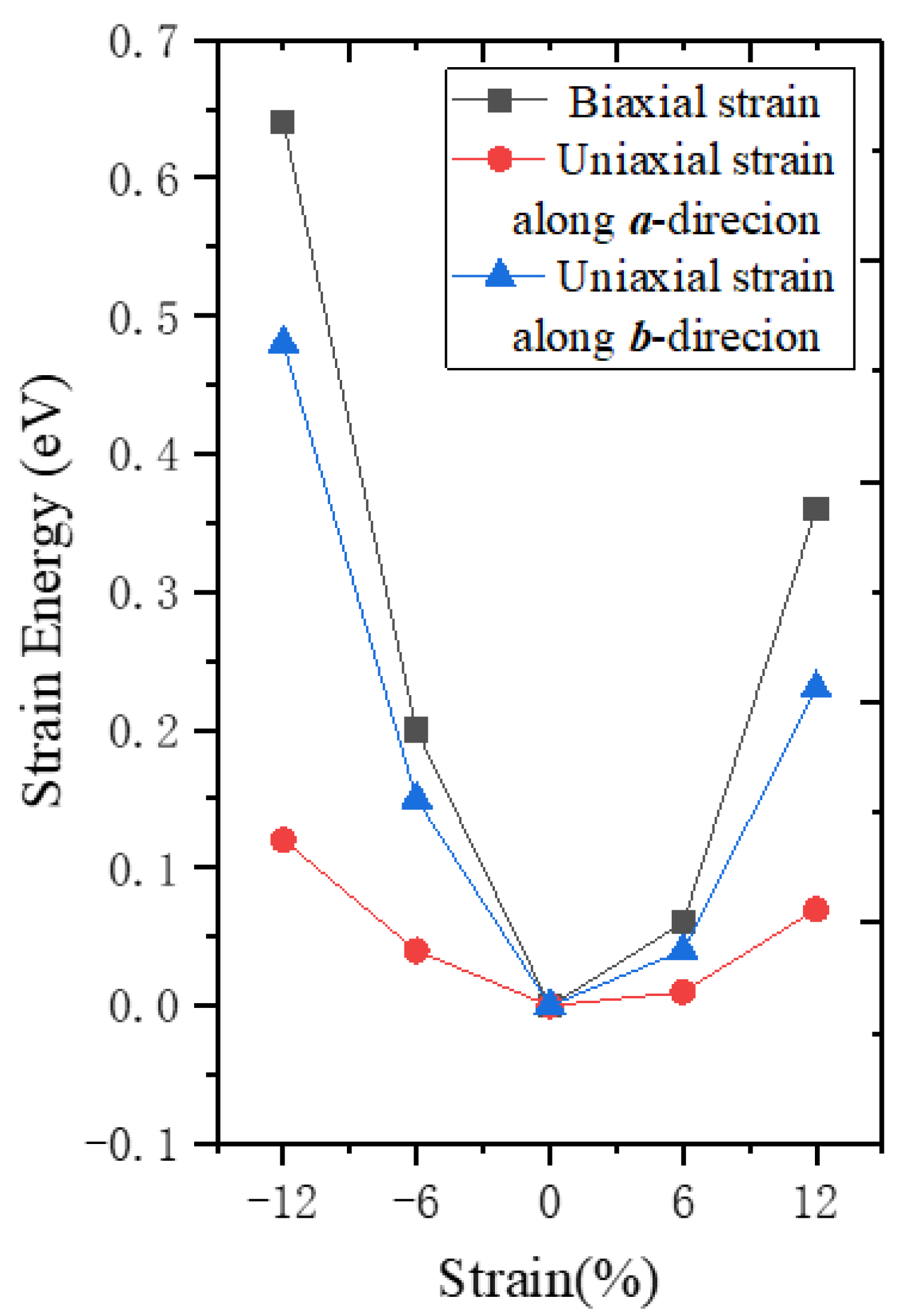
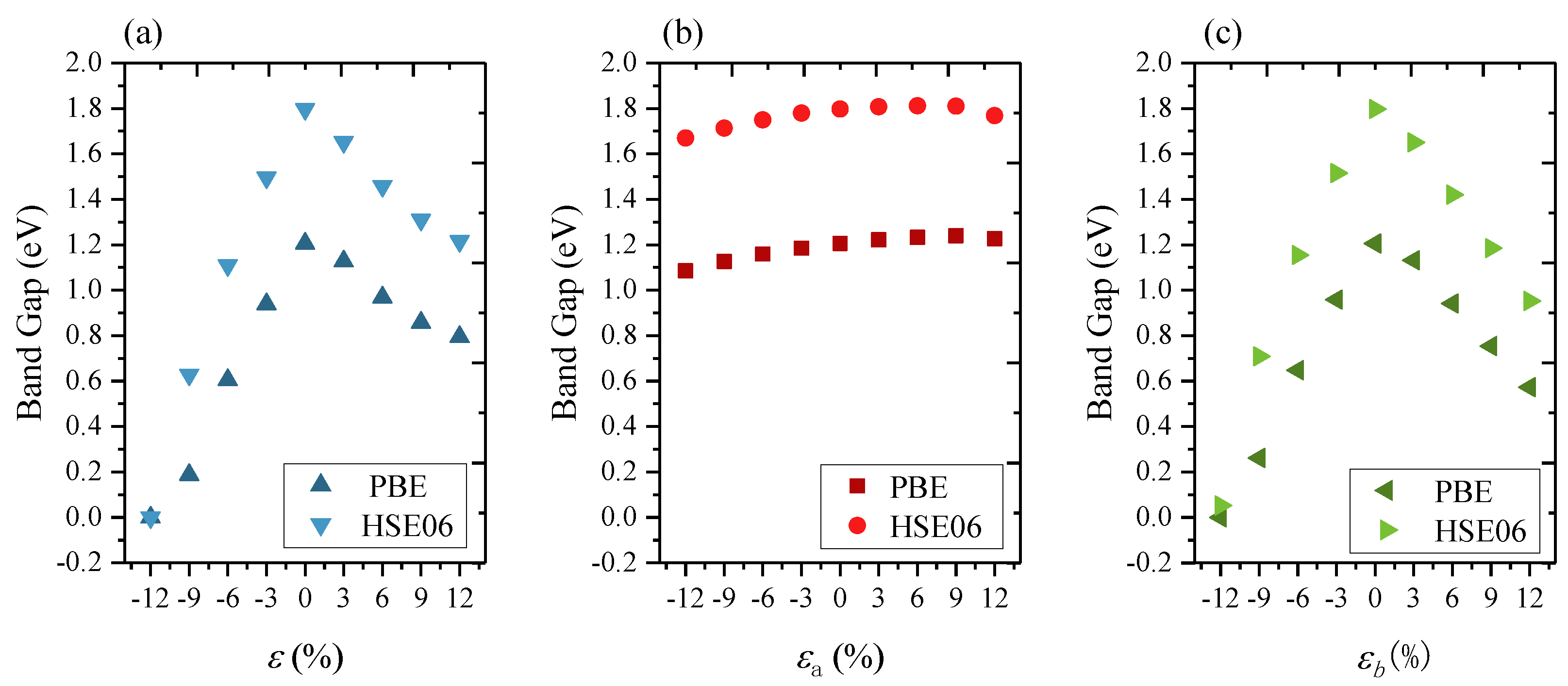
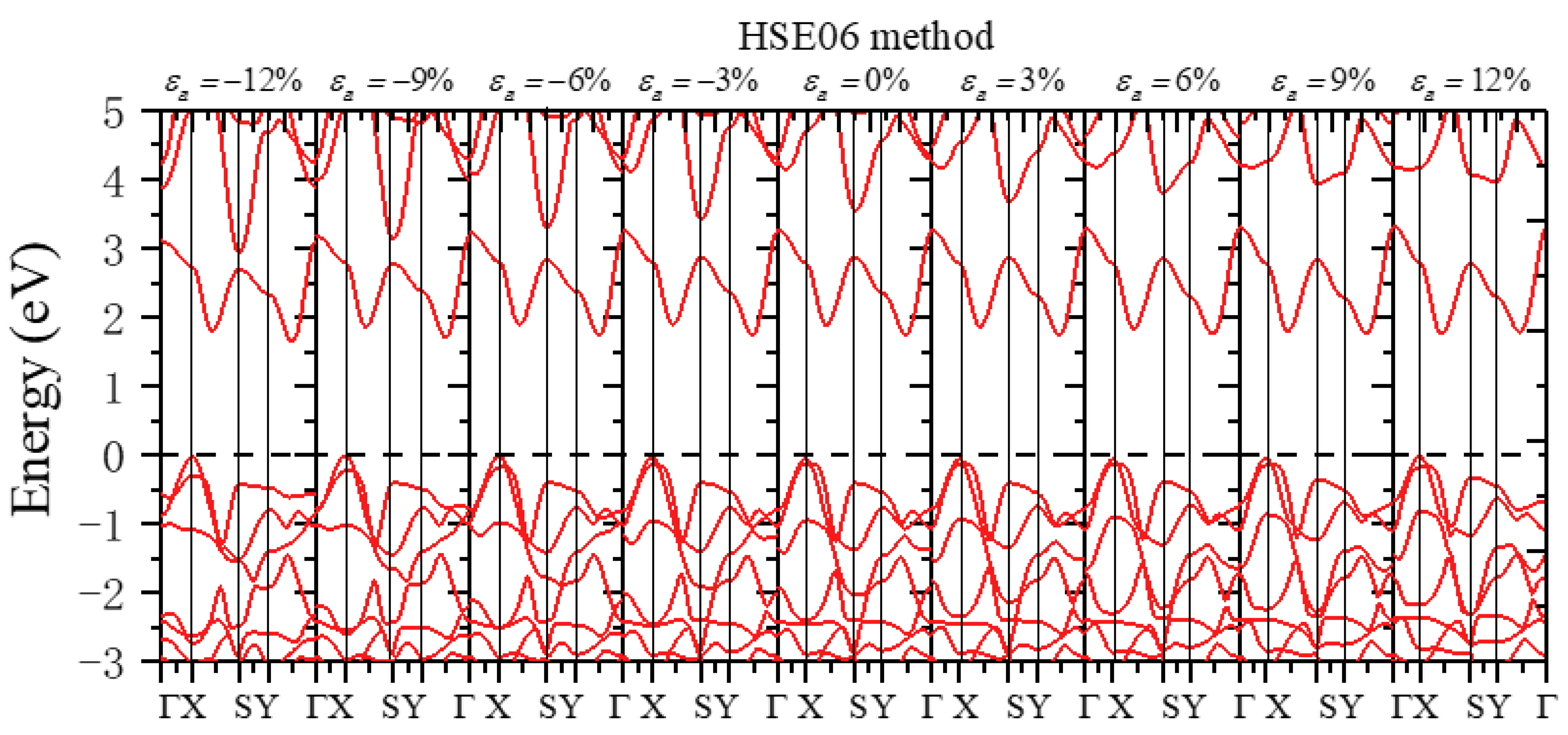
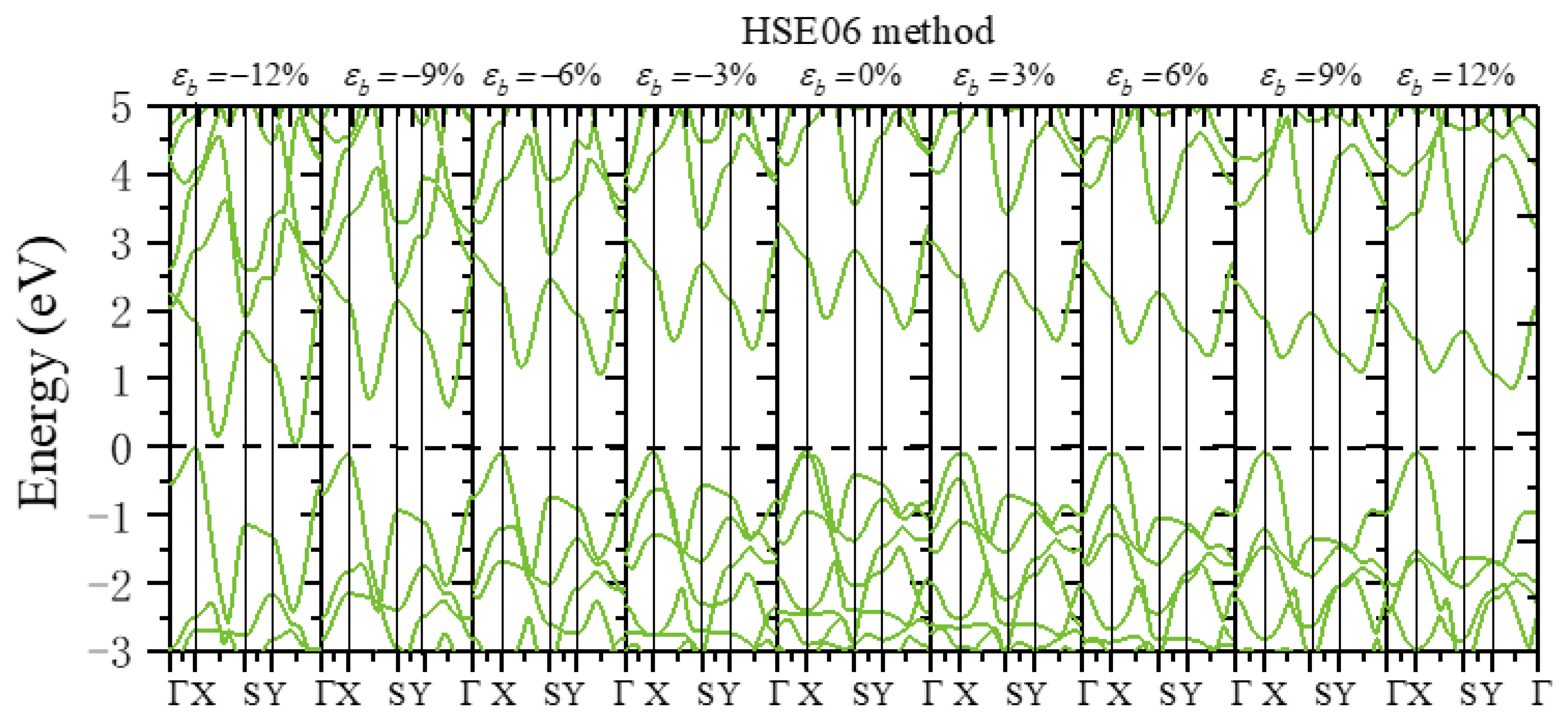

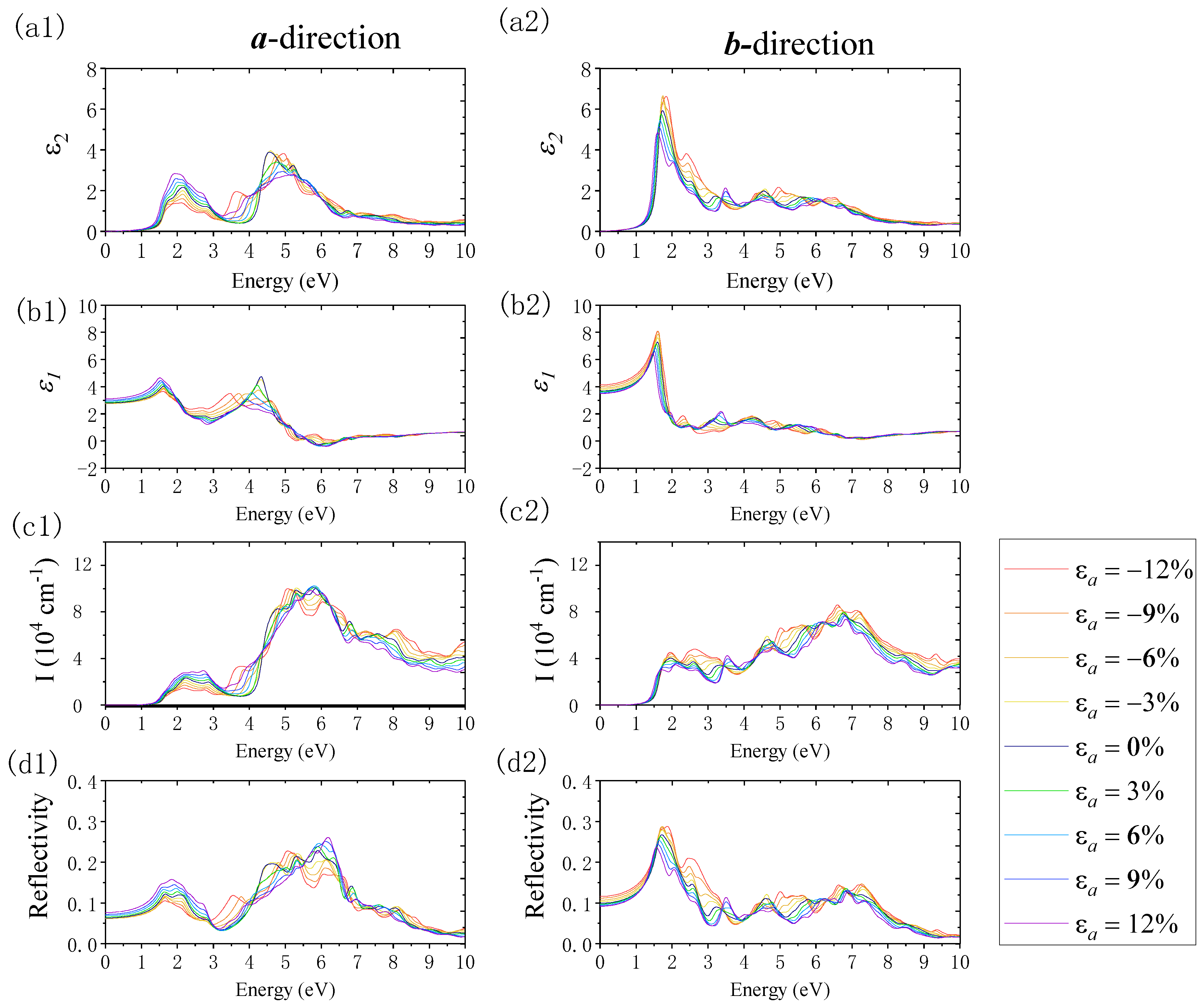
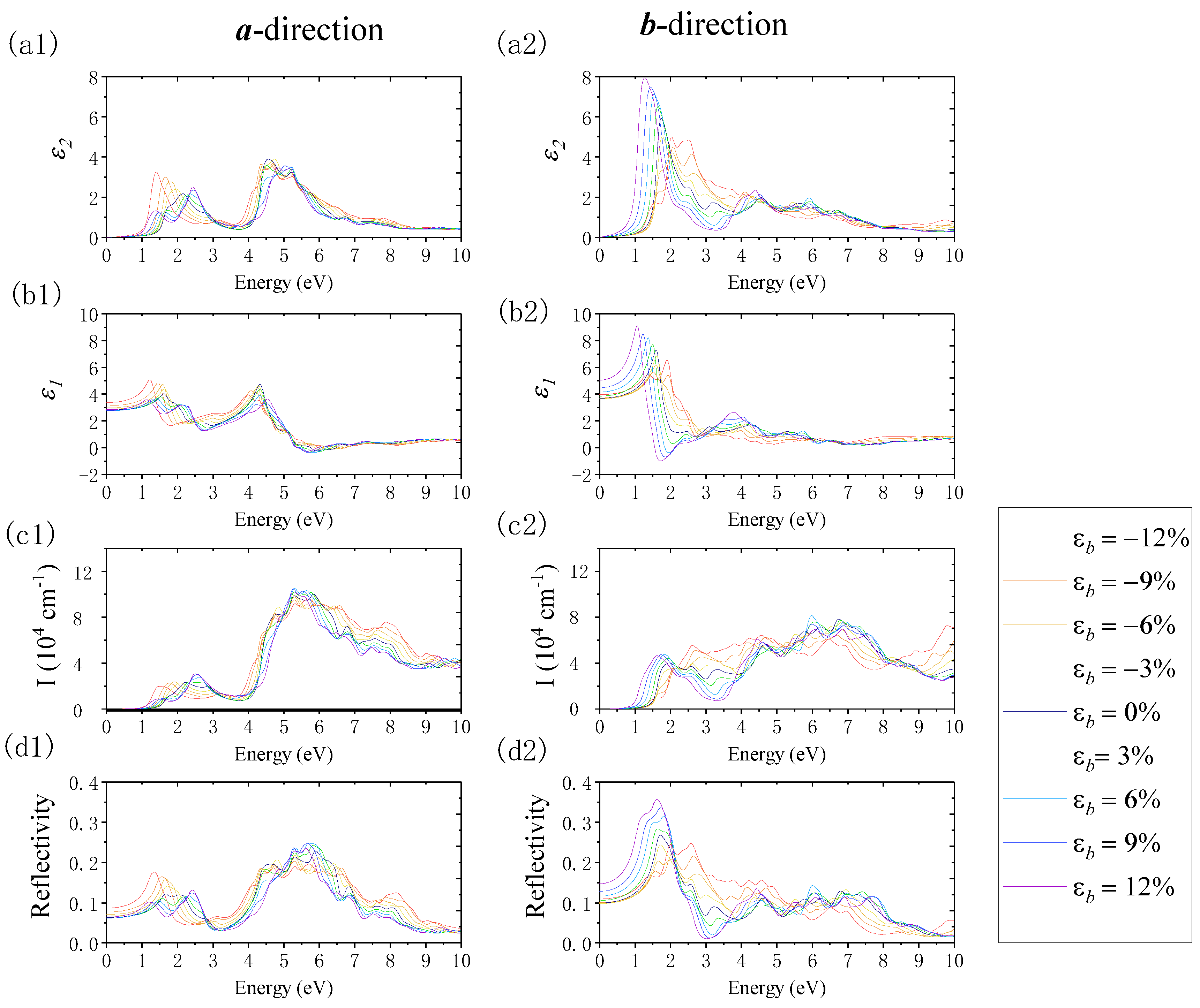

Publisher’s Note: MDPI stays neutral with regard to jurisdictional claims in published maps and institutional affiliations. |
© 2022 by the authors. Licensee MDPI, Basel, Switzerland. This article is an open access article distributed under the terms and conditions of the Creative Commons Attribution (CC BY) license (https://creativecommons.org/licenses/by/4.0/).
Share and Cite
Chen, Q.-Y.; Zhao, B.-R.; Zhao, Y.-F.; Yang, H.; Xiong, K.; He, Y. Tuning the Electronic and Optical Properties of the Novel Monolayer Noble-Transition-Metal Dichalcogenides Semiconductor β-AuSe via Strain: A Computational Investigation. Nanomaterials 2022, 12, 1272. https://doi.org/10.3390/nano12081272
Chen Q-Y, Zhao B-R, Zhao Y-F, Yang H, Xiong K, He Y. Tuning the Electronic and Optical Properties of the Novel Monolayer Noble-Transition-Metal Dichalcogenides Semiconductor β-AuSe via Strain: A Computational Investigation. Nanomaterials. 2022; 12(8):1272. https://doi.org/10.3390/nano12081272
Chicago/Turabian StyleChen, Qing-Yuan, Bo-Run Zhao, Yi-Fen Zhao, Hai Yang, Kai Xiong, and Yao He. 2022. "Tuning the Electronic and Optical Properties of the Novel Monolayer Noble-Transition-Metal Dichalcogenides Semiconductor β-AuSe via Strain: A Computational Investigation" Nanomaterials 12, no. 8: 1272. https://doi.org/10.3390/nano12081272





